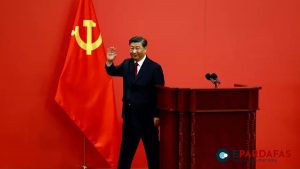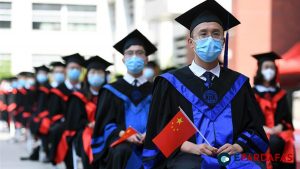
US Congressional Report Reveals China’s Backdoor Access to U.S. Technologies via Academic Partnerships

A new US congressional report has revealed that Communist China has gained “back-door access” to U.S. technologies, including sensitive military advancements, through partnerships between American academic institutions and Chinese researchers. This development has been facilitated by millions of dollars in U.S. taxpayer-funded research, indirectly bolstering Chinese military capabilities, according to the report.
The findings, a collaboration between Republicans on the House Select Committee on the Chinese Communist Party (CCP) and the House Education and Workforce Committee, spotlight alarming trends in U.S.-China academic collaborations. Over the past decade, U.S. researchers, backed by federal funding, have worked closely with Chinese counterparts on cutting-edge technologies with dual-use applications—technologies that the People’s Liberation Army (PLA) could leverage in future conflicts.
Key Findings: Military-Grade Technologies at Risk
The report identified several areas of concern, including hypersonics, directed energy, nuclear and high-energy physics, artificial intelligence, and autonomy. These technologies, which have both civilian and military applications, are critical to U.S. defense but are now at risk of being used by the PLA against U.S. forces.
“These are not innocuous technologies with civilian-only applications,” the report states. “Rather, they are cutting-edge technologies, militarily useful in the western Pacific, that the PLA can and will use against U.S. servicemembers in the event of a conflict.”
According to the report, U.S.-funded researchers have collaborated with Chinese counterparts in over 8,800 publications supported by the Department of Defense (DOD). Furthermore, more than 2,000 of these papers were co-authored with individuals directly affiliated with China’s defense research and industrial sectors. Some of these research collaborations were also linked to U.S. intelligence agencies.
U.S. Officials Alarmed
Rep. John Moolenaar (R-Mich.), chairman of the House Committee on the Chinese Communist Party, described the findings as “alarming,” emphasizing that U.S. taxpayer dollars have been unwittingly used to advance Chinese military technology. “The Chinese Communist Party is driving its military advancements through U.S. taxpayer-funded research,” Moolenaar stated. He also criticized the existence of joint U.S.-China research institutes as a critical avenue for this technology transfer.
Rep. Virginia Foxx (R-N.C.), chairwoman of the House Education and Workforce Committee, echoed these concerns, stating that it is unacceptable for U.S. tax dollars to be funneled into efforts that help China’s military advancement. “Our taxpayer dollars should be used in our country to advance our systems and not to help the communist Chinese advance theirs,” Foxx said.
Case Studies: U.S. Funds Supporting PLA-Linked Researchers
The report features six case studies that highlight how U.S. federal funds have indirectly aided Chinese military advancements. One notable example involves a researcher, identified as “Researcher 4,” who secured $22 million in U.S. federal funding from agencies such as the Department of Energy and NASA. This individual, who has participated in CCP talent programs since 1992, also held numerous positions at Chinese institutions closely tied to China’s military, including the state-owned Chinese Academy of Sciences.
The researcher reportedly filed hundreds of patents in China, many of which were based on research conducted during their U.S. tenure, signaling a clear transfer of expertise funded by American taxpayers. This individual was even honored in a ceremony attended by Chinese leader Xi Jinping and top military officials.
Joint Institutes: Pathways for Technology Transfer
The report also scrutinizes joint U.S.-China academic institutes, such as the Tsinghua-Berkeley Shenzhen Institute (TBSI) and the Georgia Tech Shenzhen Institute (GTSI). These partnerships have enabled American academics to work closely with Chinese researchers and students, often serving as pipelines for the transfer of sensitive technology to the Chinese military.
In a positive development, the report noted that Georgia Tech and the University of California–Berkeley have recently cut ties with Chinese entities following the release of these findings. However, Georgia Tech contested the report’s claims, stating that there was no research conducted at GTSI involving federal funds or technology transfer to China.
Recommendations: Strengthening Legal Safeguards
The report does not accuse any individuals or institutions of breaking U.S. law. However, it emphasizes the need for stronger legal frameworks to prevent sensitive technology from falling into the hands of adversaries. Moolenaar advocated for “tightening the guardrails” to ensure that taxpayer dollars, particularly defense funds, do not support research collaborations with Chinese military-linked entities.
Several policy recommendations were outlined, including the passage of the Deterring Foreign Influence in Higher Education Act, which would increase transparency by lowering the reporting threshold for foreign gifts to universities. Additionally, Congress should consider banning federally funded researchers from collaborating with high-risk Chinese entities, particularly those affiliated with the PLA and other defense-related organizations.
The report also called for greater oversight of joint academic institutes between U.S. and Chinese universities, arguing that they present significant national security risks.
Growing Awareness, But Challenges Remain
Gabriel Scheinmann, executive director of the Alexander Hamilton Society, stressed that while Congress is starting to pay attention to the issue, significant challenges remain. He noted that the problem of U.S. universities collaborating with Chinese institutions on sensitive research is not illegal under current law, highlighting the need for legislative changes to address the issue.
“It’s nice to see Congress start to wake up and pay more attention to it, but obviously, they have a long way to go to actually solving the problem,” Scheinmann said.
The report represents a crucial step in raising awareness about the growing influence of China in U.S. academic research. As Moolenaar concluded, “We know that the Chinese Communist Party is becoming more aggressive at home and around the world, and is using every means to infiltrate our institutions and really disrupt our way of life.”
Moving Forward
The congressional report calls for swift and decisive action to safeguard U.S. technologies and prevent further exploitation by China. As lawmakers continue to scrutinize U.S.-China academic collaborations, the future of these partnerships remains uncertain. With mounting concerns about national security, it is clear that a more robust legal and regulatory framework is needed to protect U.S. technological advantages from adversarial nations like China.












Comments